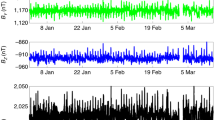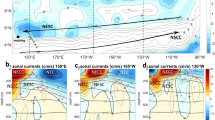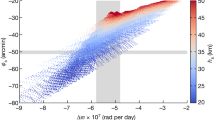Abstract
The Galileo spacecraft has been orbiting Jupiter since 7 December 1995, and encounters one of the four galilean satellites—Io, Europa, Ganymede and Callisto—on each orbit. Initial results from the spacecraft's magnetometer1,2 have indicated that neither Europa nor Callisto have an appreciable internal magnetic field, in contrast to Ganymede3 and possibly Io4. Here we report perturbations of the external magnetic fields (associated with Jupiter's inner magnetosphere) in the vicinity of both Europa and Callisto. We interpret these perturbations as arising from induced magnetic fields, generated by the moons in response to the periodically varying plasma environment. Electromagnetic induction requires eddy currents to flow within the moons, and our calculations show that the most probable explanation is that there are layers of significant electrical conductivity just beneath the surfaces of both moons. We argue that these conducting layers may best be explained by the presence of salty liquid-water oceans, for which there is already indirect geological evidence5,6 in the case of Europa.
This is a preview of subscription content, access via your institution
Access options
Subscribe to this journal
Receive 51 print issues and online access
$199.00 per year
only $3.90 per issue
Buy this article
- Purchase on Springer Link
- Instant access to full article PDF
Prices may be subject to local taxes which are calculated during checkout



Similar content being viewed by others
References
Kivelson, M. G.et al. Europa's magnetic signature: report from Galileo's first pass on December 19, 1996. Science 276, 1239–1241 (1997).
Khurana, K. K., Kivelson, M. G., Russell, C. T., Walker, R. J. & Southwood, D. J. Absence of an internal magnetic field at Callisto. Nature 387, 262–264 (1997).
Kivelson, M. G. Discovery of Ganymede's magnetic field by the Galileo spacecraft. Nature 384, 537–541 (1996).
Kivelson, M. G.et al. Amagnetic signature at Io: initial report from the Gallileo magnetometer. Science 273, 337–340 (1996).
Carr, M. H.et al. Evidence for a subsurface ocean on Europa. Nature 391, 363–365 (1998).
Pappalardo, R. T.et al. Geological evidence for solid-state convection in Europa's ice shell. Nature 391, 365–368 (1998).
Parkinson, W. D. Introduction to Geomagnetism 308–340 (Scottish Academic, Edinburgh, (1993)).
Neubauer, F. M. Nonlinear standing Alfvén wave current system at Io: Theory. J. Geophys. Res. 85, 1171–1178 (1980).
Owen, C. J. et al. The lunar wake at 6.8 RL: WIND magnetic field observations. Geophys. Res. Lett. 23, 1263–1266 (1996).
Khurana, K. K. & Kivelson, M. G. Ultra low frequency MHD waves in Jupiter's middle magnetosphere. J. Geophys. Res. 94, 5241–5254 (1989).
Ip, W-H. Europa's oxygen exosphere and its magnetospheric interaction. Icarus 120, 317–325 (1996).
Kliore, A. J., Hinson, D. P., Flasar, F. M., Nagy, A. F. & Cravens, T. E. The ionosphere of Europa from Galileo radio occultations. Science 277, 355–358 (1997).
Neubauer, F. M. The subalfvénic interaction of the Galilean satellites with the Jovian magnetosphere. J. Geophys. Res. (Planets) 103, 19843–19866 (1998).
Montgomery, R. B. in American Institute of Physics Handbook 125–127 (McGraw Hill, New York, (1963)).
Colburn, D. S. & Reynolds, R. T. Electrolytic currents in Europa. Icarus 63, 39–44 (1985).
Kargel, J. S. & Consolmagno, G. J. Magnetic fields and the detectability of brine oceans in Jupiter's icy satellites. Lunar Planet. Sci. Conf. XXVII, 643–644 (1996).
Schubert, G., Spohn, T. & Reynolds, R. in Satellites (eds Burns, J. A. & Matthews, M. S.) 224–292 (Univ. Arizona Press, Tucson, (1986)).
Anderson, J. D. Europa's differentiated internal structure: inferences from four Galileo encounters. Science(in the press).
Reynolds, R. T. & Cassen, P. On the internal structure of the major satellites of the outer planets. Geophys. Res. Lett. 6, 121–124 (1979).
Kirk, R. L. & Stevenson, D. J. Thermal evolution of a differentiated Ganymede and implications for surface features. Icarus 69, 91–135 (1987).
Cassen, P. M., Reynolds, R. T. & Peale, S. J. Is there liquid water on Europa? Geophys. Res. Lett. 6, 731–734 (1979).
Squyres, S. W., Reynolds, R. T., Cassen, P. M. & Peale, S. J. Liquid water and active resurfacing on Europa. Nature 301, 225–226 (1983).
Ross, M. N. & Schubert, G. Tidal heating in an internal ocean model of Europa. Nature 325, 133–134 (1987).
Ojakangas, G. W. & Stevenson, D. J. Thermal state of an ice shell on Europa. Icarus 81, 220–241 (1989).
Durham, W. B., Kirby, S. H. & Stern, L. A. Creep of water ices at planetary conditions: a compilation. J. Geophys. Res. 102, 16293–16302 (1997).
McCord, T. B.et al. Salts on Europa's surface detected by Galileo's Near Infrared Mapping Spectrometer. Science 280, 1242–1245 (1998).
Stevenson, D. J. in Proc. Europa Conf. 69–70 (San Juan Capistrano Research Inst., San Juan Capistrano, CA, (1996)).
Anderson, J. D.et al. Distribution of rock, metals, and ices in Callisto. Science 280, 1573–1576 (1998).
Anderson, J. D., Lau, E. L., Sjogren, W. L., Schubert, G. & Moore, W. B. Gravitational constraints on the internal structure of Ganymede. Nature 384, 541–543 (1996).
Schubert, G., Zhang, K., Kivelson, M. G. & Anderson, J. D. The magnetic field and internal structure of Ganymede. Nature 384, 544–545 (1996).
Jackson, J. D. Classical Electrodynamics 2nd edn 338 (Wiley, New York, (1975)).
Connerney, J. E. P. Magnetic fields of the outer planets. J. Geophys. Res. 98, 18659–18679 (1993).
Khurana, K. K. Euler potential models of Jupiter's magnetospheric field. J. Geophys. Res. 102, 11295–11306 (1997).
Kivelson M. G.et al. Europa and Callisto; induced or intrinsic fields in a periodically varying plasma environment. J. Geophys. Res. (submitted).
Acknowledgements
We thank D. Bindschadler of the Jet Propulsion Laboratory for support in all phases of data collection and J. Mafi for data processing and preparation of data plots. This work was partially supported by the Jet Propulsion Laboratory.
Author information
Authors and Affiliations
Corresponding author
Rights and permissions
About this article
Cite this article
Khurana, K., Kivelson, M., Stevenson, D. et al. Induced magnetic fields as evidence for subsurface oceans in Europa and Callisto. Nature 395, 777–780 (1998). https://doi.org/10.1038/27394
Received:
Accepted:
Issue Date:
DOI: https://doi.org/10.1038/27394
This article is cited by
-
The Europa Clipper Gravity and Radio Science Investigation
Space Science Reviews (2023)
-
Volcanism in the Solar System
Science China Earth Sciences (2023)
-
The Europa Clipper Magnetometer
Space Science Reviews (2023)
-
Investigating Europa’s Habitability with the Europa Clipper
Space Science Reviews (2023)
-
Exploring the Interior of Europa with the Europa Clipper
Space Science Reviews (2023)
Comments
By submitting a comment you agree to abide by our Terms and Community Guidelines. If you find something abusive or that does not comply with our terms or guidelines please flag it as inappropriate.



